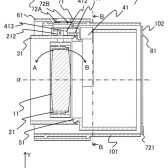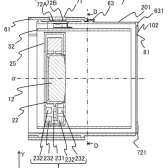A patent showcasing some new tilt-shift lens technology has surfaced from Canon. We have had both the Canon TS-R 14mm f/4L and Canon TS-R 24mm f/3.5L on our RF lens roadmap for quite some time. It has been rumoured that these will be autofocus tilt-shift lenses.
The patent here discusses electronic control of of the tilt function of a tilt-shift lens.
If Canon pulls off both autofocus and electronic controls on their new RF mount tilt-shift lenses, that will be pretty revolutionary.
Canon Patent
PROBLEM TO BE SOLVED:
To enable a user to intuitively and quickly perform an operation for tilting shooting.
BACKGROUND
- By tilting or shifting a lens with respect to an image pickup surface, it is possible to obtain a tilting effect such as tilting a subject surface in focus with respect to the image pickup surface. Patent Document 1 has two operating rings on the outer periphery of the lens barrel, and the orientation (rotation position) of the tilt axis of the lens in the lens barrel around the optical axis can be changed by rotating the first operating ring. Disclosed is a lens device capable of changing the tilt direction around the tilt axis of a lens by rotating the second operating ring.
- However, in the lens device disclosed in Patent Document 1, since the rotation operation direction of the second operation ring does not match the tilt direction of the actual lens, the user intuitively operates the second operation ring. May not be possible.
- Moreover, since the orientation of the tilt axis changes due to the rotation of the first operating ring, the user confirms the orientation by visually observing the first operating ring before operating the second operating ring. Need to keep. Further, when adjusting the direction of the tilt axis to tilt the lens, the user needs to move his / her hand from the first operation ring to the second operation ring. For these reasons, it is difficult for the user to operate quickly.
- The present invention provides a lens device that allows a user to intuitively and quickly perform an operation for tilting photography.
- The drive unit 41 is fixed at a position on the outer periphery of the guide cylinder 31 at a position orthogonal to the tilt axis β from the optical axis α. The drive unit 41 is a motor (actuator) having a lead screw 411 that rotates around an axis parallel to the optical axis α, and generates a driving force that tilts the holding frame 22. The guide cylinder 31 is held by the fixed cylinder 51 so as to be rotatable around the optical axis α by bayonet coupling.
Some of our articles may include affiliate links. If you purchase through these links, we may earn an affiliate commission at no extra cost to you.






If a user could input where they want a plane of focus somehow, Canon could theoretically use the information it gets from phase detect to figure out the angle and tilt it. That would be amazing. It would mean more of a run-and-gun use case, where now tilt/shift lenses are for the slow, considered shooters.
But if you take the existing EF tilt/shift lenses and put the RF premium on them; then add the supply chain premium, then add this new innovation premium, it hurts thinking about how much they'd cost.
Very interesting patent!
But honestly I can't afford the TSE lenses and this one never, never, never. :cry:
An automated tilt-function would be sensational!
PS: who needs a pre-owned kidney?
But I will not switch by TSE17 for this electronical feature. How expensive they might be? 5k? (double) or even more? No way. For architectural photography the current lenses are ok. I don't like the "make it louder, go to eleven!" thing to replace it by an 14mm... Then the distance between the common 24mm is to high. (or do they want also add a 19mm or so in the middle?)
“What about this lens”
“Don’t touch that lens….”
“Don’t even look at it”.
Brian
Personally I don't think it would be worth it.
I think one of the things that makes the TS-E great is that it is manual focus so you are far more precise in what you are doing as you are checking focus.
Motorised tilt is interesting but I wonder really. It's a function I don't use much. The current controls are not precise, hard to make minor adjustments.
I wonder would a motorised version be much better. It's like those motorised lens you can get for micro 4/3 or superzoom bridge cameras, they tend not to be that controlable. You'd want to be able to make micro adjustments.
Sometimes adding technology doesn't make it better.
This would render obsolete the complex and boring calculation of focus distribution. Also ideal for handheld photography!
I have to say though, that the MF aids are so good with the R5 (and I assume R6 and R3 at least) that I haven't missed AF on my 2 TS-E lenses
There is a difference between
- tilting (the topic of the patent)
- and shifting (your not so wise proposal)
No, a 10-500 zoom will not do the job.
A tilt engine has
- to tilt the whole tube with all lens elements.
- to rotate the whole mechanism to get the tilt orientation needed.
Frankly, I hardly can imagine this to happen (robustness).
And the user interface dealing with at least three independent focus points seems a challenge for me as well. (This is to be done by the body, not the lens)
The Laowa 15 and 20mm shift lenses have a lens ring approach to shift and I find it very useful when using the shift axis set at arbitrary directions (I still have the 20mm here from my recent testing/review)
Lens ring based adjustments for shift/shift axis/tilt/tilt axis/focus will make for some interesting ergonomic design challenges. Explaining how to actually use such functions (and, for example, the practical limitations of tilting the focus plane) will make for some interesting challenges in screen UI and user education and expectation management ;-)
A previous 2019 patent is worth looking at if you're interested in automation of some aspects of tilt use [ USPTO ]
My suspicion is that an updated tilt/shift mechanism, the latest in optical designs and T/S EXIF data are far more important to people willing to pay for lenses like this than AF and motorised functions.
No doubt the IQ will be Canon-like! (The price will be CanonRF-like too, sadly). But I want it!!!!
I often use shift-lenses in landscape photography (forest-trees, canyons, mountains etc...) I just hate converging lines!
This doesn't look like a wide angle lens. The front element is in a housing which cut of the edges of wider lenses.
Probably this patent is aimed at unique portrait lenses or something different. These use cases would also more profit from electronic control. A landscape or real estate shooter is able to spent some seconds in adjusting the lens. They also are more interested in the shift function which this patent seems to lag.